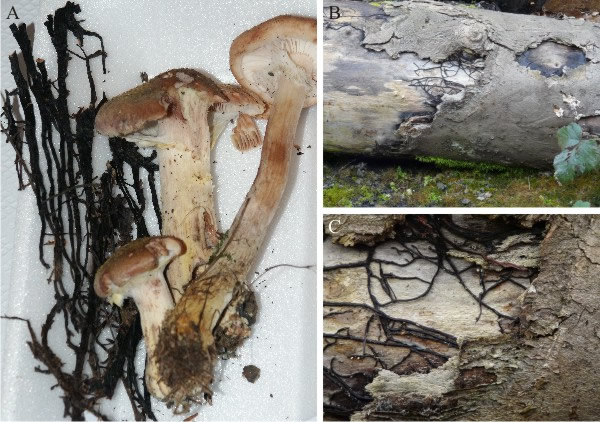14.4 Armillaria (Basidiomycota)
Several species of Armillaria cause ‘Honey Fungus’ (or ‘Bootlace Fungus’) diseases of trees and shrubs. It’s an extremely aggressive pathogen. One individual clone of A. ostoyae has been found in the mixed-conifer forest in the Blue Mountains/Malheur National Forest of northeast Oregon in the USA which is estimated to be over 1,900 years old and has killed 30% of the Ponderosa pines in its area. This is currently the world’s largest individual organism and covers 965 ha (9.65 km2 or 2,384 acres) of forest. The maximum distance between isolates from this 965-ha individual was approximately 3.8 km and use of three estimates of the rate of Armillaria ostoyae spread in conifer forests resulted in age estimates for the fungus ranging from a minimum of 1,900 to a maximum of 8,650 years (Ferguson et al., 2003).
Some years earlier a clone of Armillaria gallica had been identified as the largest and oldest living organism (Smith et al., 1992) in a northern Michigan hardwood forest; this individual was ‘only’ 15 ha (37 acres) in size and 1,500 years old; it is celebrated by the people of Crystal Falls, Michigan in their Humongous Fungus Fest every August. However, within a few months of the publication of Myron Smith’s paper in 1992, Terry Shaw, then in Colorado with the US Forest Service, and Ken Russell, of the Washington State Department of Natural Resources, reported that they had been working on an even larger fungus, Armillaria ostoyae, that covered over 600 hectares (1,500 acres, 2.5 square miles) south of Mt. Adams in southwestern Washington State (Volk, 2002).
Massive, old fungi are not uncommon and large individuals of Armillaria are certainly not limited to the USA; in the Swiss National Park in the Central European Alps Armillaria ostoyae individuals averaged 6.8 ha in size (that's 68,000 m2), the largest so far reported being approximately 37 ha (Bendel et al., 2006). Basidiomycete mycelia are ubiquitous in forest soils and several studies show that mycelia of many ectomycorrhizal, saprotrophic and pathogenic basidiomycetes can spread vegetatively for considerable distances through forest soil (Cairney, 2005; Bendel et al., 2006).
What enables Armillaria to spread rapidly through a stand of trees and bushes, especially in cold and relatively dry conditions, is the combination of its aggressive pathogenicity with its rhizomorphs. The multi-hyphal highly organised, highly protected, structures allow water and nutrients to be transported across the forest floor from the existing food base to support the exploratory, foraging rhizomorph tips as they search for more food bases (Fig. 3) (see Section 9.7). Clearly, then the rhizomorphs contribute enormously to Armillaria pathogenicity, and established mycelia of this fungus are essentially permanent, so Armillaria root diseases must be diseases of the site. Armillaria ostoyae is a native pathogen in North America, with a broad host range, though it is most common and damaging on Douglas-fir, grand fir and subalpine fir. Mortality rates are highest in warm, moist habitats but large disease patches can develop even on dry sites, and cold, elevated sites as well. In large areas of northern Idaho and western Montana the range of the pathogen includes most of the best timber-producing sites. The best course of action to minimise crop losses is to select tree species that will survive in Armillaria-infested soil (Hagle, 2010).
 |
|---|
| Fig. 3. Honey fungus or Bootlace fungus, Armillaria mellea. A, fruit bodies and rhizomorphs (photograph by David Moore). B, rhizomorphs visibly emerging from beneath the bark of a felled log. C, close-up of the rhizomorphs shown in B (photographs B and C by Elizabeth Moore). |
|
Resources Box 14.1 Where to find more information about crop diseases, crop losses, plant pathogens and food and agriculture statistics We have a page giving references to scientific papers and hyperlinks to online resources.
CLICK HERE |
Updated July, 2019
